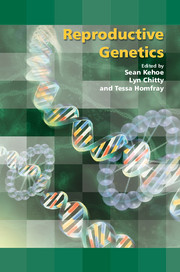Book contents
- Frontmatter
- Contents
- Participants
- Declarations of personal interest
- Preface
- 1 Genetic aetiology of infertility
- 2 Disorders of sex development
- 3 Preimplantation genetic diagnosis: current practice and future possibilities
- 4 Ethical aspects of saviour siblings: procreative reasons and the treatment of children
- 5 Epigenetics, assisted reproductive technologies and growth restriction
- 6 Fetal stem cell therapy
- 7 Prenatal gene therapy
- 8 Ethical aspects of stem cell therapy and gene therapy
- 9 Fetal dysmorphology: the role of the geneticist in the fetal medicine unit in targeting diagnostic tests
- 10 Fetal karyotyping: what should we be offering and how?
- 11 Non-invasive prenatal diagnosis: the future of prenatal genetic diagnosis?
- 12 Non-invasive prenatal diagnosis for fetal blood group status
- 13 Selective termination of pregnancy and preimplantation genetic diagnosis: some ethical issues in the interpretation of the legal criteria
- 14 Implementation and auditing of new genetics and tests: translating genetic tests into practice in the NHS
- 15 New advances in prenatal genetic testing: the parent perspective
- 16 Informed consent: what should we be doing?
- 17 Consensus views arising from the 57th Study Group: Reproductive Genetics
- Index
9 - Fetal dysmorphology: the role of the geneticist in the fetal medicine unit in targeting diagnostic tests
Published online by Cambridge University Press: 05 February 2014
- Frontmatter
- Contents
- Participants
- Declarations of personal interest
- Preface
- 1 Genetic aetiology of infertility
- 2 Disorders of sex development
- 3 Preimplantation genetic diagnosis: current practice and future possibilities
- 4 Ethical aspects of saviour siblings: procreative reasons and the treatment of children
- 5 Epigenetics, assisted reproductive technologies and growth restriction
- 6 Fetal stem cell therapy
- 7 Prenatal gene therapy
- 8 Ethical aspects of stem cell therapy and gene therapy
- 9 Fetal dysmorphology: the role of the geneticist in the fetal medicine unit in targeting diagnostic tests
- 10 Fetal karyotyping: what should we be offering and how?
- 11 Non-invasive prenatal diagnosis: the future of prenatal genetic diagnosis?
- 12 Non-invasive prenatal diagnosis for fetal blood group status
- 13 Selective termination of pregnancy and preimplantation genetic diagnosis: some ethical issues in the interpretation of the legal criteria
- 14 Implementation and auditing of new genetics and tests: translating genetic tests into practice in the NHS
- 15 New advances in prenatal genetic testing: the parent perspective
- 16 Informed consent: what should we be doing?
- 17 Consensus views arising from the 57th Study Group: Reproductive Genetics
- Index
Summary
Introduction
A clinical geneticist can have several roles in a fetal medicine unit: assisting with management of the family at high risk of a genetic condition, aiding the interpretation of complex chromosome rearrangements and facilitating the diagnosis of a fetus with structural anomalies but apparently normal chromosomes. With increasing routine use of prenatal sonography for the diagnosis of fetal anomalies and the technological improvements in ultrasound machines, more fetal abnormalities are being detected. Defining the prognosis for a fetus with structural abnormalities if the karotype is abnormal can be reasonably straightforward but cases with apparently normal chromosomes are more challenging. Accurate prenatal diagnosis of rare syndromes is becoming an increasing reality with the advances in ultrasonography and molecular technology. Such accuracy is not always possible prenatally, and postnatal confirmation is thus essential.
For the past two decades, increasing numbers of gene mutations have been identified that allow invasive prenatal diagnosis in subsequent pregnancies in early gestation, giving parents in many countries around the world choices in the management of affected pregnancies. This does, however, require a couple to have a family history of a disorder, with accurate confirmation of the diagnosis, usually before pregnancy. In the absence of a family history, an abnormality will only be identified by a screening test. Screening tests during pregnancy fall into two groups:
■ those identified on blood tests, such as sickle cell trait, and first- and second-trimester biochemical screening for Down syndrome
■ those identified on ultrasound.
Keywords
- Type
- Chapter
- Information
- Reproductive Genetics , pp. 131 - 146Publisher: Cambridge University PressPrint publication year: 2009

